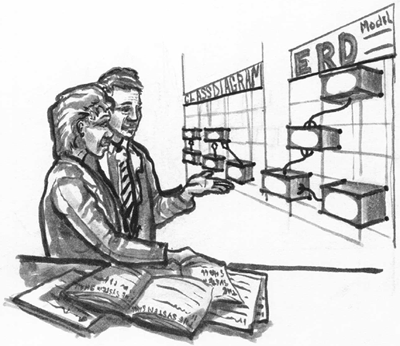1.1 First and Least of All . . .
| Technical people often pay much more attention to an entity relationship diagram or class diagram than to a requirements list. Each time a team of systems people sets out to provide a computer system for a group of business people, they proceed through a set of activities that is fairly consistent:
The emphasis that the team gives each phase determines the direction and quality of the resulting computer system. If one activity is not given its due, there will be predictable problems with the project and the end product. In reality, however, certain activities usually receive more attention than do other activities. It is not easy to explain why this occurs, but it does. The activities that are usually ignored or paid lip service are
Traditionally, fewer vendors brandish flashy tools to accomplish these activities, and maybe that's why they are less interesting and less appealing to practitioners . Certainly, a great deal of creativity and a wide range of skills are required by each activity, but the perception has been that anything other than the big three ”analysis, design, and construction ”does not require much attention or imagination . This perception is slowly changing, in no small part because vendors are building tools to manage requirements (Rational RequisitePro, Borland Caliber RM, Telelogic DOORS), automate testing (Segue SilkTest/SilkPerformer, Mercury Interactive WinRunner/LoadRunner, Rational Robot/TeamTest/TestManager), and to facilitate rollout (Borland Deployment Server/Java, Marimba Desktop/Mobile, BEA WebLogic). Maintenance has also received a small boost with the need for Y2K remediation in recent years . We have opinions on ways to improve the visibility, appeal , and effectiveness of these other underappreciated activities, but we'll spare you those points until our next book. We wrote this book because we care about requirements. In the first place, effective requirements are pivotal to producing a system that meets the needs of the users. It's no exaggeration to say that the requirements themselves are the needs of the users. Moreover, we have grown to care about requirements because we have seen more projects stumble or fail as a result of poor requirements than for any other reason. Because requirements are meant to drive the rest of systems development, any small misstep is amplified into a major flaw by the time deployment is in progress. Correcting those flaws becomes extremely time-consuming (read: expensive!) because so much work has been put into heading in the wrong direction. Unfortunately, requirements do not translate neatly into one discrete module in a coded computer system. Sometimes, they are embodied in principles that cut across many code libraries and components . Because requirements are so abstract and so different from computer programs, it is difficult for people whose skills lie in the concrete aspects of computer programming to get them right. Traditionally, requirements gathering
A short time ago, we came across a requirements definition document that contained more than 160 pages of "requirements." The sheer volume of this requirements list was enough to cause us to be filled with panic (or at least dread ) at the thought of reading it and attempting to put the pieces together. Table 1.1 contains a sample of the requirements list (which is not very different from many other lists we've seen). Table 1.1. Example of a Requirements List
Don't forget this list continues for another 159 pages! We dissect these and other requirements statements later, but you can imagine how difficult it would be to read large volumes of information at this level, much less to separate the true requirements from trivialities. If you are reading this book, you have probably lived this problem. One reason that requirements documents are often so bad is that requirements gathering frequently follows an unproductive route. For example, it may be ignored; in that case, the development team jumps to a solution, resulting in a design based on unwritten and not agreed-upon assumptions about how the system should work. Or requirements gathering becomes an end in itself, and pages of "requirements" are gathered, documented, cross-referenced, and distributed, resulting in analysis paralysis and cancellation of the project before the rest of the lifecycle can even be started. Or the requirements may be dictated by a single user , system owner, or high-ranking manager, resulting in a system that works only for that person, to the dissatisfaction of everyone else. None of these methods produces satisfactory input to the analysis activity. Hundreds of application lifecycle activities definitions, taken from various methodologies and processes, litter our bookshelves and the Internet. In Table 1.2 we provide our definitions of these terms because we build on these definitions to explain how to best approach requirements gathering. Table 1.2. Activity Definitions
Our definitions of lifecycle activities are not taken from any specific methodology. Instead, we've attempted to choose the most commonly used names and definitions for each term . Notice we've chosen the word activity instead of the word phase . We do this deliberately. In waterfall lifecycles, activities (or workflows), and phases are synonymous. However, activity relates to something that a person or group does. Phase implies specific start and stop times, dependencies, and a sequence. With iterative/incremental lifecycles, on the other hand, phases and activities are quite different. (We explain our approach to iterative/incremental lifecycles in Chapter 7.) Activities are done iteratively and incrementally, but phases are simply project management milestones that indicate a number of increments or a natural break in the lifecycle. For example, the Rational Unified Process (RUP) has the following workflows (activities): business modeling, requirements, analysis and design, implementation, test, deployment, configuration/change management, project management, and environment. It also has the following phases: inception, elaboration, construction, transition, and evolution. We see most methodologies moving in the same direction as the RUP to accommodate developers' as well as project managers' viewpoints. |
EAN: 2147483647
Pages: 90
